- contact@scarhandpainting.com


Ahoy Sailors! As you know I am most and foremost a passionate hobbyist. That being said, I am also a pirate, a scoundrel and a fanatical enthusiast of Mantic Games Kings of War: Armada – a naval strategy game set in the rich world of Pannithor, pitting multiple wonderfully crafted and strongly themed factions against one another. Today I’m here to share some of my maritime experience.
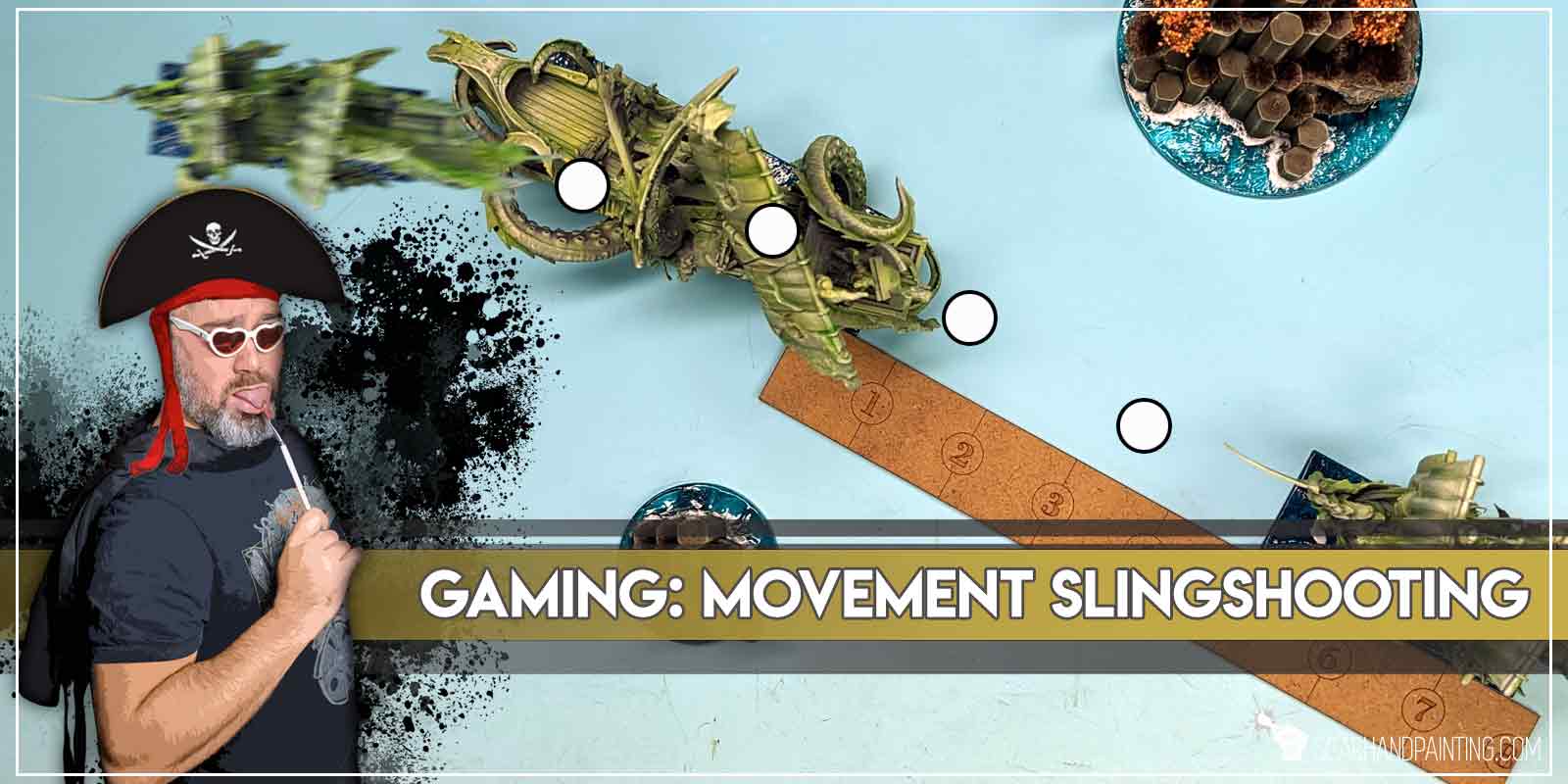
Armada is a fast and relatively simple game to play. So far the Mantic games have done an amazing job keeping the rules mostly smooth and the faction balance in place. Still it is a wargame with (as of today) rules spread across three books and fifteen factions. With such a wealth of rules there is no way to avoid a few niche rules interactions that might feel a bit unintuitive to newer players, such as Baiting Collisions and awkward Visibility cases to name a few. This is also the case with ‘Slingshooting’ – an interaction allowing players to increase movement of their ships by leveraging Move based rules to sail through friendly ships.
There currently are two fleets capable of Slingshooting: the Tridern Realms (Fully Submerged) and the Ghost Fleets (Spectral Form). They both follow a similar slingshot mechanic, but with its own set of pros and limitations.
Fully Submerge, the Trident Realms faction rule
“Trident Realm ships can automatically Fully Submerge to avoid other ships that they would otherwise collide with during their own activation, as long as the Trident Realm ship can be placed with its rear base edge a few mm clear of the other ship, following the same initial trajectory. This completes the movement of that Move Step, and the ship continues with its normal activation. Any Shooting attack during this activation will be with an additional -2 to-hit modifier. This modifier is not cumulative with the -1 to-hit modifier for having rolled to evade during the activation. If the ship cannot be placed with its rear base clear of the other ship, the normal evade procedure must be undertaken. A Trident Realm ship may only Fully Submerge once during its activation.”
The Trident Realms ships are allowed to completely avoid one Collision per Activation, but going under and effectively moving to the other side of the obstructing ship instead. The procedure works as follows:
Although the Fully Submerge rule allows to avoid collisions, the Trident Realms ships are still a subject to the Avoid Collisions While Moving rule (Rulebook p.16) stating as follows:
“If it is not the last Move Step in a ship’s activation, ensure its forward movement in the next Move Step will not result in a potential collision (with terrain or another ship). If this would result in a potential collision, alter the ship’s turn to avoid this as much as legally permitted.
Sometimes however, due to forward momentum, lack of turn angle, poor planning or just bad luck, collisions will be unavoidable (see page 20).”
What this means is, even though the Trident Realms ships have a tool to “avoid other ships that they would otherwise collide with“, Rules as Written, they are still not allowed to set themselves for a “potential collision” during Move Steps other than the “last Move Step”.
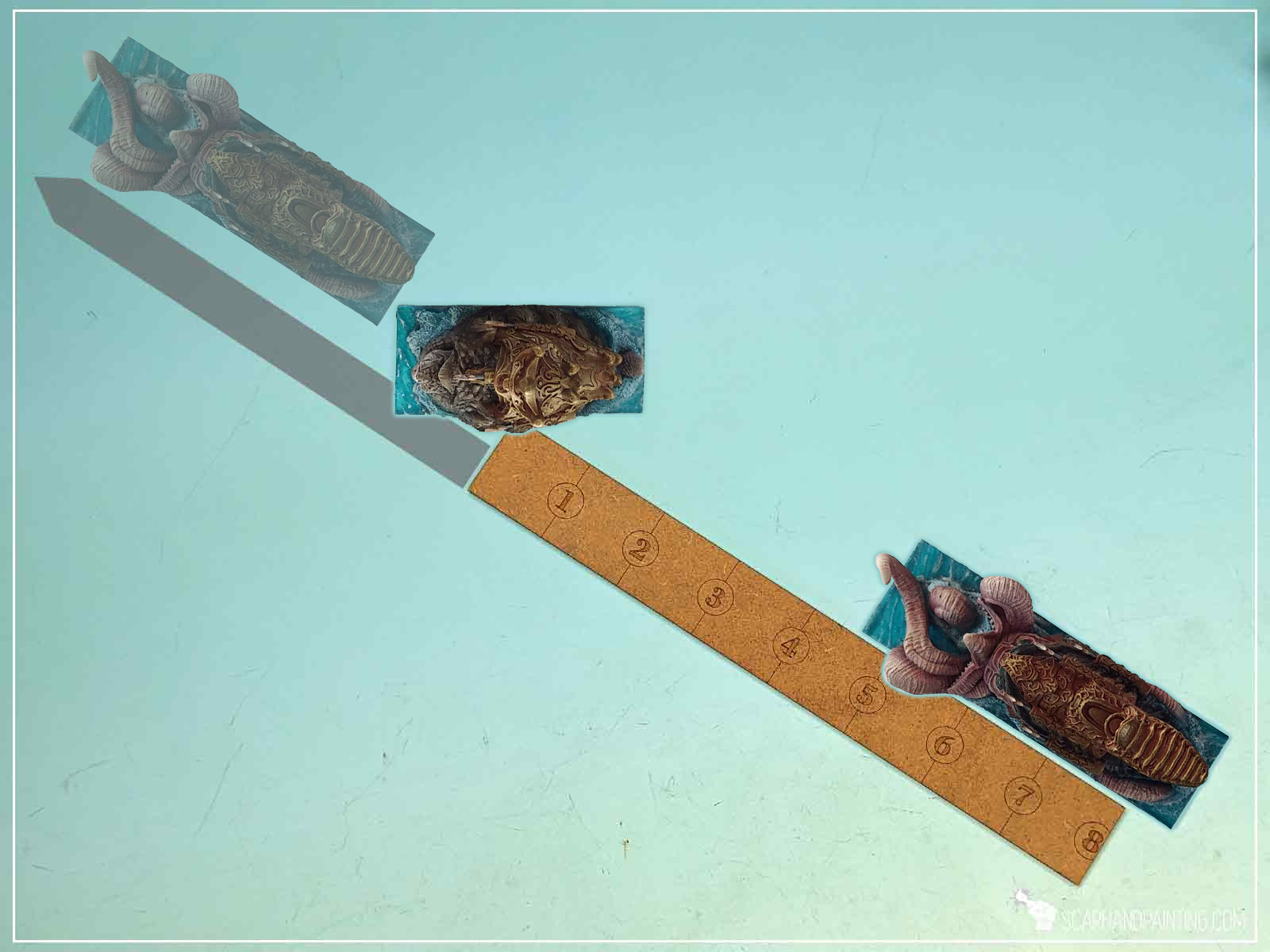
Trident Realms painted by Michał “MiSiO” Ciemniewski
Example A: During Activation a Gun Turtle (Main Battleship M) sets itself up 4,5″ directly in front of a Giant Squid (Main Battleship L). When activated, during first Move Step the Giant Squid is on a collision course with the Gun Turtle, elects to Fully Submerge and moves behind the other ‘fish’ adding the length of both the Gun Turtle’s and its own base to the movement, effectively doubling the movement in this Move Step. It then continues the Activation as normal.
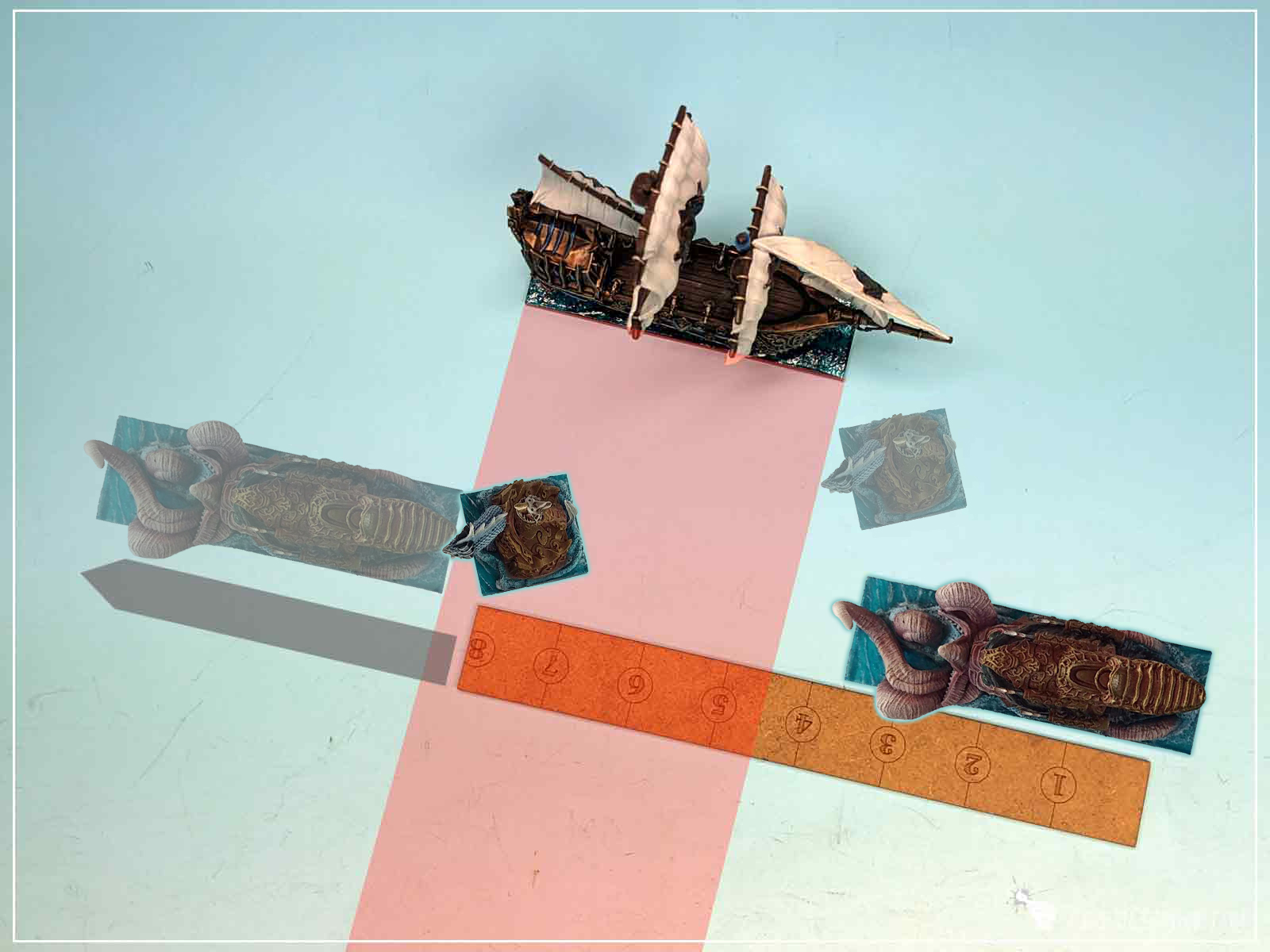
Trident Realms painted by Michał “MiSiO” Ciemniewski
Example B: An enemy Abess (Main Battleship L) is positioned so that the Giant Squid (Main Battleship L) will inevitably end its first Move Step within the Basilean ship’s Broadside Arc and possibly trigger a Fire as She Bears salvo. The Wyrm-Drawn Sloop Squadron (Support Ship T) Activates next. To avoid the Basilean trap the Trident Realms player moves the Squadron 4,5″ in front of the Giant Squid. The Giant Squid Activates next and elects to Fully Submerge moving behind the Squadron and finishing Move Step outside of the Basilean Broadside Arc.
Even if the Basilean player decided to use Fire as She Bears against the Squadron, the Giant Squid would end up safe.

The Fully Submerge Slingshooting is free of any downsides other than planning ahead of time and setting up miniatures to be able to benefit from the extra movement. Depending on situation you can set up a fast smaller ship ahead of a heavier, much slower and much more melee capable fish, such as a Lieviathan, to close the distance in a single rapid hoop. What if it allowed the Larger ship to attempt a Grapple after an extended Battle Speed, when it would otherwise be unable to reach near the target? Or, when threatened with a Fire as She Bears, move chaff in the way to Slingshoot a more expensive ship beyond the enemy Broadside Arc. Sleazy fish tactics, or just naval superiority of the Trident Realms?
Spectral Form, the Ghost Fleets faction rule
“If a ship from this fleet Surrenders, is Grounded, or its SPs have been exceeded, remove the model from the table. Ghost ships do not suffer or inflict collisions with other ships. Instead, the activating ship completes its move as normal. If the activating ship would not end clear of the other ship, add enough movement until it does end clear, and then continue with the Activation. Each ship passed through (including the Ghost ship) will cause damage equal to a D10 plus its own CS to the other ship. e.g. An Elohi with CS 4 collides with a Spectre with CS 6. The Elohi inflicts 1D10 + 4 damage to the Spectre, and the Spectre inflicts 1D10 + 6 damage to the Elohi. Tiny ships take and inflict half damage (rounding up). Note that Ghost ships cannot deliberately ram/pass through an enemy ship. Ghost ships can never be set ablaze. Ghost Fleets always have Regular Crew, and this cannot be changed.“
The Ghost Fleet ships do not suffer Collisions with other ships, but pass through one another by adding movement necessary to do so. The procedure works as follows:
On most occasions this will happen naturally on a Ghost ship’s Activation – an Enemy ship is in the way, Ghost ship moves through, they both deal damage to one another, end of story. To avoid dealing devastating damage to the enemy fleet there’s a limiting factor in place in the form of “Note that Ghost ships cannot deliberately ram/pass through an enemy ship.”, similar to “Players must avoid deliberately ramming or colliding with other ships and terrain, unless a rule says otherwise.” from Collisions section in the Main Rulebook. Note the Spectral Form’s choice of words, that refers to “enemy” ships exclusively. This means that although passing through friendly ships will still cause damage to both ships, the Players are allowed to deliberately position their ships and move through friendlies.
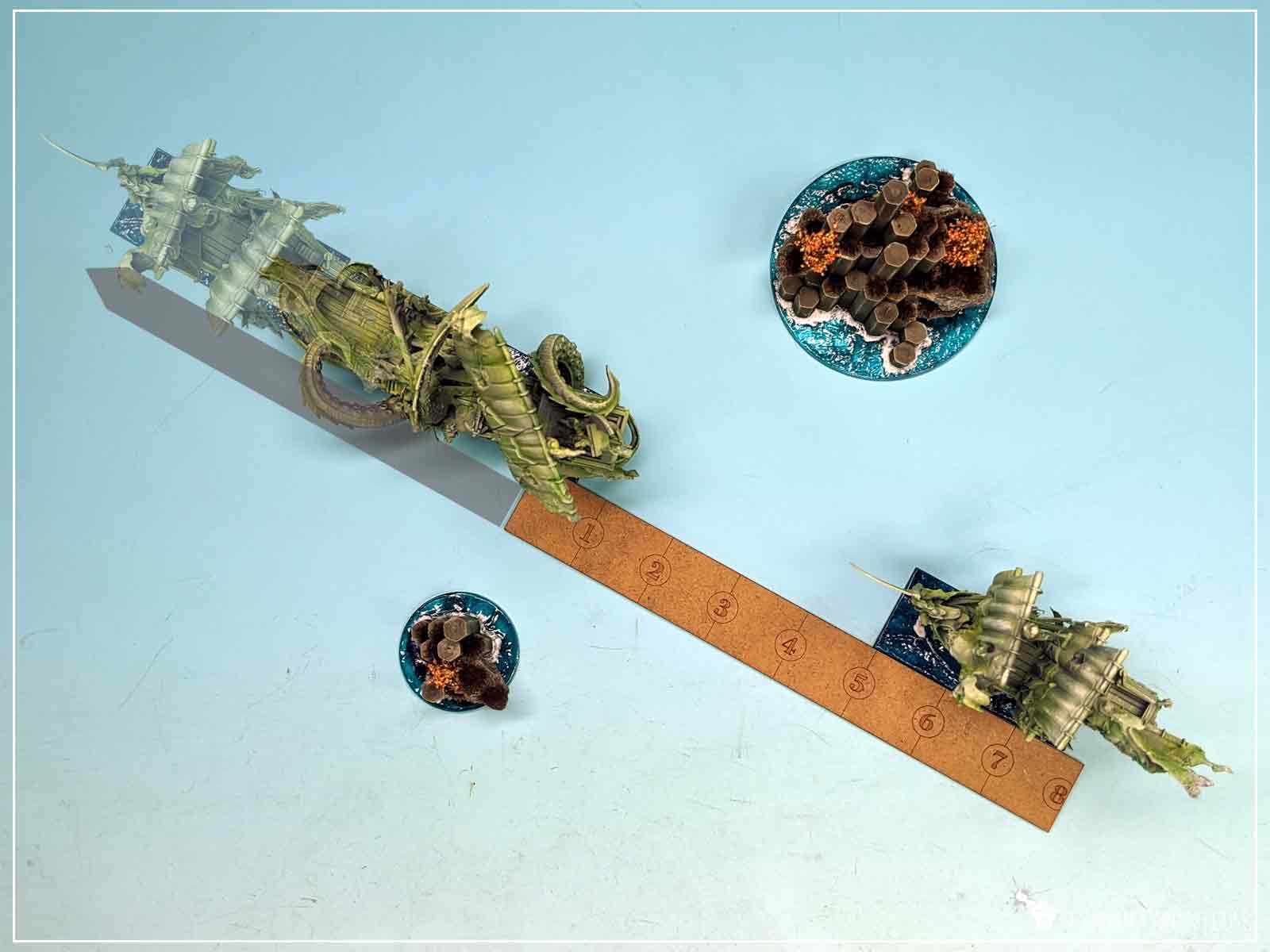
Example C: With its second Move Step a Phantom (Main Battleship M) sets itself up on a ‘collision*’ course with a Spectre (Main Battleship L) at a distance of 4,5″. On its next Move Step the Phantom will move 4,5″ and through the Spectre adding the length of both the Spectre’s and its own base to the movement, effectively doubling the movement in this Move Step. Both ships will deal damage to each other.
*Ghost Fleets ships are unaffected by Collision rules with other ships. I used ‘collision’ for a lack of a better term.
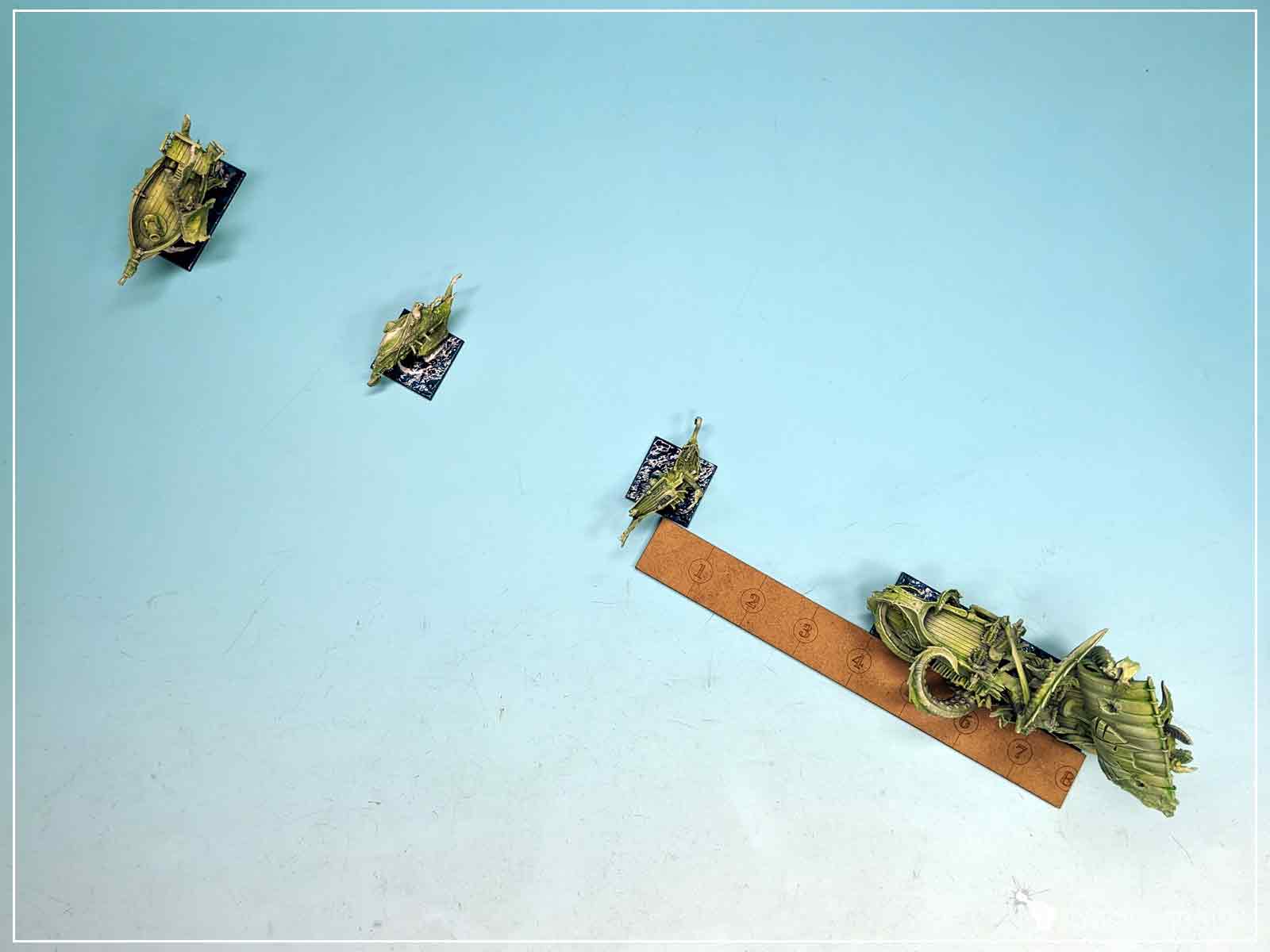
Example D: With its second Move Step a Spectre (Main Battleship L, base length about 4″) sets itself up on a ‘collision*’ course with a Shadow (Support Ship T) at a distance of 3,5″. On its next Move Step the Spectre will move 3,5″ and through the Shadow adding the length of both the Shadow’s and its own base to the movement – BUT – there is another Shadow in the way (further 3,5″ away) and then a Wight (Support ship S) another 3,5″ further. The Spectre would effectively multiply its movement exponentially, but will damage and in return be damaged by all three friendly ships.
*Ghost Fleets ships are unaffected by Collision rules with other ships. I used ‘collision’ for a lack of a better term.

Although much more risky than the Trident Realms Slingshooting, the Ghost Fleets mechanic has some niche uses. For starters let’s say that in the last turn of a seemingly lost game of ‘sink and survive’ type Scenario, the Ghost Fleets player may want to sacrifice some chaff (T ships are usually worth 0 VP when destroyed in such scenarios) to position the active Large / Extra Large ship in range of all weapons and try to sink a barely afloat enemy ship/s. Or in a ‘area control’ scenario friendly ships can be used as a springboard to Slingshot the active ship into the VP worth area on the board. Niche? Yes! But can it be meaningful? Definitely, to a point of winning the game with. Food for ghostly thoughts.

I hope you find this article interesting. Be sure to let me know your thoughts in the comments below or via Facebook or Instagram. I would also appreciate it if you considered sharing this content with your friends, who might find it useful. Finally if you are looking for a professional Warhammer miniatures painting service, be sure to contact me with this contact form. I always reply within 24 hours, after which please check out your spam folder.
2 comments so far
cpPosted on6:28 am - Oct 24, 2023
Right off the bat, thank you for your awesome tutorial articles, it is truly a treasure for new players.
As for the slingshot maneuvers, Fully Sumberged’s Rules-as-Intended first paragraph should have the “…and if the Trident Realm model have had enough movement to completely move past the enemy ship” clause. You can almost always place your model’s stern in contact w the enemy ship, and as you’ve demonstrated, in case of larger ships this can boost the ship well over its M value which cleaely wasn’t the intention with this rule.
Ghostly is a whole other beast (no pun intended), but changing “Enemy” to “friendly and enemy ships” in the moving/ramming limitation would solve the issue.
ScarhandpaintingPosted on7:45 pm - Oct 24, 2023
Thanks for the feedback. As it happens I am currently a part of the Rules Committe and was a part of the design team working on the Trident Realms – slingshioting came up during beta tests and we decided to leave it be. Until proved problematic on a wide scale and errated, it works as intended. 😉